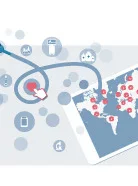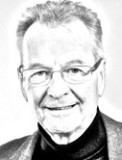HerzstiftungOltenis a local foundation connected to the Swiss Heart Foundation. I initiated the foundation of the Herzstiftung Olten 25 years ago. I realised, that a national organisation has difficulty to reach people on the ground. National heart foundations are usually supporting cardiovascular research and besides are active in making national TV and radio commercials, production of information material flyers and support websites including health information platforms. However, with a local heart foundation we saw that—when local cardiologists are actively involved on the board of such a foundation—we can have further impact on cardiovascular health in the region.
We do regional research, we are very close to schools and to our personal networks. We have done research on lifestyle and we did research on heart disease i.e. asking women and men why they waited so long to go to the hospital when they had chest pain. It took two more hours for women with acute myocardial infarction to go to the hospital compared to men, because women were less aware. We have been able to change this situation by awareness campaigns specifically targeted at women. Now women do not take a longer time to get to the hospital in case of myocardial infarction, and have the same chance to survive as men when they have a heart attack.
What are your key areas of interest and research?
During the last three years my key interests turned towards new technologies for elderly people, with the aim of keeping them as independent as possible for as long as possible with a good quality of life. This is becoming the overall most important problem in healthcare in the world, looking at the growing percentage of elderly people in society. There are predictions that if elderly people need care, if they become dependent in large numbers, the society cannot afford that any more. There was a prediction that Switzerland would need 160,000 more nurses to take care of them by the year 2040.
I’m doing research on biosensors, working at the ARTORG Center for Biomedical Engineering Research at the University of Bern . The aim there is that engineers and doctors work together. We hope that when elderly people are carrying bio-signal devices, we can get preventive information to keep them independent. When we see from an accelerometer that they move less, we can call them and recommend activation or physiotherapy. When we see that their heart rate is becoming irregular, we may see that they have atrial fibrillation and in a timely manner offer anti-coagulation therapy before a stroke occurs.
What are the major challenges in your field?
The gap between expectations from the community from ehealth and health informatics and the clinical application. When I have a new biosensor it takes more than one year to test it in a certain number of seniors, then another half year to a year till we have results published and find out what the next step should be. Today in this fast evolving situation in informatics technology, it’s boring sometimes to see how much groundwork you need to show that something is valuable, can help to improve the situation and that it is cost-effective.
What is your top management tip?
About 20 years ago I was asked to work at the University Clinic for Cardiology at the Inselspital Bern, the largest Cardiology Department in Switzerland to build up a unit for cardiovascular rehabilitation and prevention. Within 10 years, we became the leading European institution for cardiovascular prevention and rehabilitation, which is integrated into a university cardiology department. For more than 17 years, the official training courses for prevention and rehabilitation are given in Bern at this institution.
What would you single out as a career highlight?
I was one of the initiators of the European Association for Cardiovascular Prevention and Rehabilitation (now the European Association of Preventive Cardiology) and I was the first president. I was co-founder and first editor in chief of the European Journal for Cardiovascular Prevention and Rehabilitation (now the European Journal of Preventive Cardiology). Another highlight was becoming official chair for acute and preventive cardiology at the First Moscow State Medical University, the largest medical university in Russia.
If you had not chosen this career path you would have become a…?
Carpenter. I had an uncle who was a carpenter. I liked the smell of the wood, and in my early years that would have been a real alternative
What are your personal interests outside of work?
I’ve been married for 42 years. My wife and I do a lot of cycling. We just came back from Magdeburg—1,300 km to Bern. We try to travel more kilometres by bicycle than by car (by more than 6000km a year). When we tour by cycle, we are in nature, make stops and talk to people. I also enjoy hiking in the Swiss mountains and travelling around the world.
Your favourite quote?
Be positive.
Biography
Hugo Saner, MD, FESC is a cardiologist. His current position is Senior Consultant and Research Associate at the University Clinics for Cardiology and Research Associate at the ARTORG Center, University of Bern, Switzerland.
Dr. Saner trained in Bern, Switzerland and at the Abbott Northwestern Hospitals and the University Hospital of Minnesota, Minneapolis, USA. In 1989 he became Assistant Professor in Internal Medicine, in 1996 Titular Professor in Cardiology, and 2008 Associate Professor of Cardiology at the University of Bern. From 1991–2004, he served on the Board of Directors of the Swiss Heart Foundation and founded the Heart Foundation in Olten, Switzerland.
Dr. Saner was Director of Cardiovascular Prevention and Rehabilitation, University Hospitals, Inselspital Bern, Switzerland, from 1997-2013.
He
was Editor in Chief of the European Journal of Cardiovascular Prevention and
Rehabilitation from 2003-2007 and President of the European Association for
Cardiovascular Prevention and Rehabilitation from 2006-2008.
His honours include honorary membership of the Romanian Society of Cardiology, Deutsche Gesellschaft für Prävention und Rehabilitation and the National Russian Society for Cardiovascular Prevention and Rehabilitation. He is Doctor Honoris Causa at the University of Timisoara, Romania.
Dr. Saner was a cofounder of the Graduate School of Health Sciences, University of Bern, and served as Committee Member until 2014. For several years, he was also Director of the Research Methods Training Courses, European Association for Cardiovascular Prevention and Rehabilitation.
Since 2012, he has a Chair for Preventive and Acute Cardiology at the I.M. Sechenov First Moscow State Medical University in Russia. He founded the EuropeanCongress on eCardiology and eHealth in 2011 and is the Congress Director.







